
London
London was familiar ground with enough new stuff to be interesting. I spent one day just wandering around familiar streets and researching pubs and beer! Once again I was frustrated by the Houses of Commons - I've still never been there. When we went to try again we found it closed! We visited a few new tourist traps - including the London Eye - reputedly the highest sightseeing Ferris Wheel in the world. The view was spectacular, but the gloomy weather was disappointing. We spent three days in London before and one after our cruise. On the last day I was lucky to be able to visit the Great British Beer Festival - an incredible display of "Real Ale". Enough to warm the heart of any home brewer. On one of the many bars I counted over 50 "Beer Engines" - the hand pumps used for serving non-pressurized, Real Ale. Pity I only had a few hours.

Tower Bridge at Night

The long bar in the Great British Beer Festival.
I counted more than 50.
Our cruise had wonderful destinations, but the food on the ship and the guides used for shore excursions were disappointing. In most places we just made our own way onshore instead of using the ship's optional tours. Exceptions were a train trip to Berlin and our visit to St.Petersburg.
Kiel Canal
The next day we sailed through the Kiel canal to the Baltic. It took most of the day and, although the day was drizzling rain, there were crowds of spectators along the whole length. A crewman told me that this happens every time they go through the canal (about every two weeks)! It seems that our ship was the highest ever to use the canal. During a renovation and expansion they put hinges on the mast and the funnels allowing them to be lowered so as to fit beneath the bridges over the canal. In spite of the weather crowds lined the whole length of the canal to see us go through.
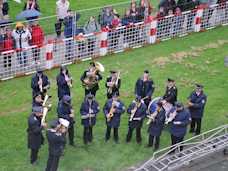 Brass Band in the rain |
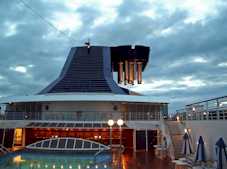 The ship's funnel and mast had been modified so it could sail under the bridges along the canal. |
Berlin

The Reichstag was completely rebuilt after the war. The 1933 fire lead to the appointment of Adolf Hitler as Chancellor.
History was palpable here.
The Nazi Air Ministry building was hardly damaged in the war - right in the center of Berlin!
Tallinn, Estonia
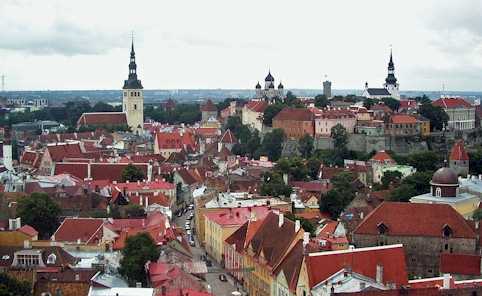
The lower town viewed from the upper town
The lower town was for trading and business; the upper town was for the nobility and government.
The Estonians flew their national flag on top of Tall Herman in 1987. They were among the first East European countries to defy the USSR. "Beer House" is a good brewpub. They had some of the best lager.
St. Petersburg
The Russians provided many very high quality bands to entertain tourists. But, on a damp gloomy morning, playing "Brasil" struck a strange note. Moika canal reminded me the "Venice of the North".
Things are in very bad repair in St. P. This wall (of the Hermitage!) is in such bad shape that they have covered it with a canvas wall like a movie set. NOTE: It is not there to allow repairs behind it - it's too close to the wall.
The Hermitage Museum is full of art students learning their trade.

art students learning their trade
The Hermitage Hall of Mirrors is much more impressive than that at Versailles.
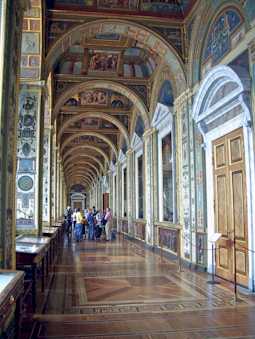
The Hermitage Hall of Mirrors
On the other hand the churches are in very good shape. This is the Cathedral "Our Savior on the Spilled Blood" built on the spot where Emperor Alexander II was assassinated in March 1881.

the Cathedral "On Spilled Blood".
Peterhof was built to out-do Versailles. It comes very close, a few things are even more impressive - such as these famous fountains. They are fed entirely by gravity from springs above the site.

Peterhof and famous fountains
Stalin's Masterpiece - the subway. Opened in the 1950's, little changed today. Some of the local inhabitants are not impressed by tourists.

subway
Helsinki
Temppleiaukio Church was blasted out of solid rock. There is a bomb shelter downstairs for 6000 people. A very Finnish combination.
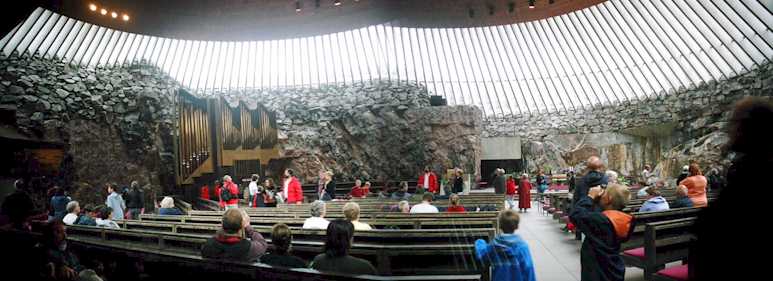
Temppleiaukio Church
The weather complimented Sibelius' memorial very well - brooding. (Don't forget this was in July!)
Stockholm
Stortorget is the main square in the old town - . We had a very good lunch under the yellow awning in the square. Real Swedish meat balls.
The Vasa was a top-heavy warship with an extra deck of guns. It capsized and sank on it's maiden voyage in Stockholm harbor (1628). It was recovered a few years ago and is displayed in very dim light (Long exposure!)
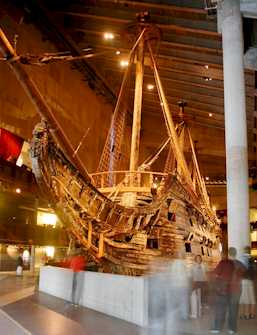
The Vasa warship
Copenhagen
Denmark has thousands of modern windmills. These stretch for miles along the Kattegat, south of Copenhagen.

modern windmills stretching for miles along the Kattegat, south of Copenhagen
This is the new Opera House, in the harbor, near the famous Little Mermaid.
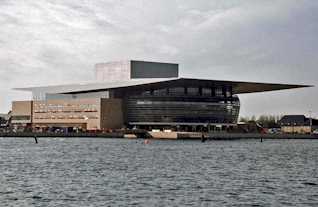
new Opera House
This Gas Generator was used during World War II. My hat will give you the scale; the brim diameter is about 34 cm. Amazingly, it is from General Motors.

Gas Generator
May 31, 2005